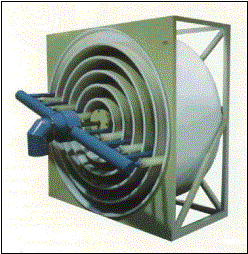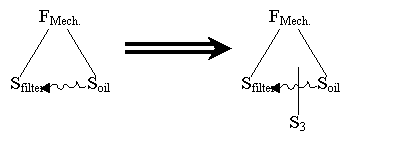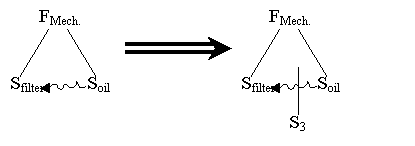
by
Josh Carr
North Carolina State University
for
TE 589A “T.R.I.Z. Problem
Solving”
College
of Textiles, N.C. State University
Professors:
Dr. Michael Slocum & Dr. Tim Clapp
May 3, 1999
The multi-drum filter, when used in a particular textile process application, encounters the problem of clogging with oil. This presented a good opportunity to apply T.R.I.Z. (The Theory of Inventive Problem Solving) methodology in order to solve this problem in an innovative fashion.
The A.R.I.Z. (The Algorithm of Inventive Problem Solving) process was followed in order to fully understand the conflict that needed to be resolved in this problem. Contradiction Matrix theory was also employed in order to generate even more solution concepts. All solution concepts are described.
An evaluation of how well T.R.I.Z. worked in this situation is given, and the complete A.R.I.Z. report is included in the appendix.
Description of Apparatus
Figure
1. Multi-Drum Filter

In the textile industry, one of the more important supporting systems is the temperature/humidification/filtration system. One of the most common elements of this system is the drum filter. This drum filter has evolved much over the years. Basically it is a simple large drum made of solid ends and supportive structure for the curved portion. This drum is then covered with a filtering media. Air from the plant is forced from the outside of the drum through to the center and is then cycled back into the plant (usually after passing through a refrigeration and/or humidification process).
Modifications of this simple design have been made over the years to make the filter more efficient, and different media have been used according to the application. One of the more innovative improvements to the simple drum filter is the “multi-drum filter”. This kind of drum filter is essentially several drums placed inside one another. Figure 1 shows the design of the multi-drum filter.
As the filter becomes “blinded” with the particles that it filters from the air, the stripping nozzles remove the filtered material from the surface of the filter. In normal operation, the same filter media can be used for as much as 6 to 8 months without being replaced.
Problem Description
One current application for this multi-drum filter is in a diaper manufacturing plant. As part of the diaper manufacturing process, oil particles are dispersed into the air and subsequently filtered by the multi-drum filter. This oil clogs the media beyond the ability for it to be stripping nozzles to clean the filter. This is causing the plant to have to replace the media in a matter of just a few weeks rather than the 6 to 8 months that is desired. It is not necessary to filter the oil, but it is unclear at this point how to filter the dust from the air without also filtering the oil. A solution to eliminate the harmful effects of the oil on the filter is desired.
A full A.R.I.Z. analysis was performed on this problem and can be seen in the Appendix. The solution concepts that were generated by the A.R.I.Z. procedure are discussed below. In addition to A.R.I.Z., solution concepts were generated using the contradiction matrix.
In addition to aiding in the definition of the problem, A.R.I.Z. also provided many opportunities to come up with solution concepts through analogous thinking. Several concept solutions were generated and are described below.
One of the first tools that was used was Su-Field modeling. The original Su-Field model of the problem is:

The addition of a third substance was recommended by the standard solution set. In the case of this problem, this led to the concept of a pre-filter that would remove the oil from the airstream before it reached the multi-drum filter. Another possible third substance could be something applied to the filter material that would give it the properties necessary to release the oil to the stripping nozzles.
Many Little People (MLP) modelling was also used in this problem. This led to the generation of a solution concept of adding a substance (perhaps a chemical additive) that would make the oil less attracted to the filter. In essence, it would allow the stripping nozzles to more easily remove the oil and eliminate clogs.
Throughout the A.R.I.Z. process, there were other solution concepts generated. First, the idea that the filter should be tightly woven to filter properly and loosely woven to release the oil clogs. This is a physical contradiction and using the separation upon condition principle, the follow solution concept evolved. A filter media that when under positive pressure contracted but under negative pressure expanded would create a situation that would allow easy stripping by the nozzles because the suction (negative pressure) would allow the clogs to be released.
Another solution concept generated was that of using the oil as a benefit. It is unclear at this point how this would be possible, but if there was a way to actually use the oil to better filter the air without clogging the filter, the ideality of the filter would be greatly increased.
Finally, the solution concept of adding an electric or electromagnetic field that could direct the oil particles in the air to a separate collection area would keep the oil from coming into contact with the multi-drum filter.
When using the contradiction matrix, the follow parameters were used:
Parameter to increase: 23. Waste of SubstanceIf oil clogs the filter, it must be replaced more often, and this is a waste of filter material.
Parameter of undesired result: 39. Productivity
If the filter is made porous enough to eliminate or decrease the clogging, it will also decrease its ability to filter the dust from the air. This is considered a decrease in productivity.
Of the 40 principles, the following were selected from the matrix: 28, 35, 10, and 23. Number 28, replacement of a mechanical system, led to the idea of separating the oil from the air by means of an electric or electromagnetic field. Number 35, transformation of chemical and physical states, led to two concepts. First, if the filter could be heated, it might allow the oil to pass completely through the filter – eliminating the clogs. Second, a chemical that reacts with oil by turning it into a solid could make it more easily removed by the stripping nozzles. Number 10, prior action, led to the idea of installing a pre-filter that would eliminate the oil. Finally, number 23, feedback, provided the idea of a system that could sense (perhaps via pressure gauge) when an “anti-clogging” action needs to be activated.
T.R.I.Z. has proved to be a very useful method here in the generation of possible solutions. Although, nothing at this time has “jumped out” as a definite solution, several of these ideas show promise. With further research into the particular fields that the solution concepts reference a solution is sure to be had.
The most valuable aspect of using T.R.I.Z. is its ability to nearly eliminate psychological inertia. Before beginning the T.R.I.Z. process, the only solutions that had been considered were those of merely changing the filter media. This is because that seemed to be the easiest way to solve the problem, but merely changing the media type was a trade-off solution because it would most like decrease the efficiency of the filter. T.R.I.Z. also led to the generation of many more useful ideas than traditional brainstorming would have. This has definitely been a successful application of the T.R.I.Z. methodology.
Appendix
ARIZ Analysis of Multi-drum filter
By Josh Carr
1. Mini-Problem Formulating
1.1
The problem is that oil is clogging the filter making premature
replacement necessary. Thus, the Direct
Key Knot is the following:
(+) Filtering Air
(-) Oil clogs filter
1.2 The filtering media (Useful Function Tool) creates filtered air (Useful Function Product).
|
Kind of term |
Object |
Object |
Action |
Object |
Action |
|
Strictly specialized |
Non-woven filter media |
Air |
Filters |
Oil |
“Blinds” |
|
Common to all technology |
Fabric |
Air |
Filters |
Oil |
Restricts |
|
Functional |
Filter |
Air |
Cleans |
Oil |
Clogs |
|
Picturesque |
Felt material |
|
Purifies |
|
Plugs up |
|
Universal |
Thing |
Thing |
Acts |
Thing |
Acts |
Typical formula of the Useful
Function is:
Filter cleans the air.
1.3
The oil (Harmful Function Tool) blinds the non-woven filter media
(Harmful Function Product).
After using Operator of
Eliminating Professional Terms:
The oil in the air clogs the filter.
1.4 The Common Element is Filter.
1.5
Graphical Scheme of the Conflict:
![]()
1.6
Additional condition is: more tightly woven filter media.
Key Knot after using Operator of
Eliminating Professional Terms:
| (+) cleaner air | |
| tighter woven filter | |
| (-) oil clogs filter faster |
1.7 IC-1: If a finer filter is used, then (+) it cleans air but (-) clogs with oil.
1.8 Reverse Key Knot:
|
(+) oil doesn’t clog |
|
| loosely woven filter | |
| (-) air isn’t filtered adequately |
1.9 Graphical Scheme of the Reverse Conflict:
![]()
1.10 IC-2: If a loosely woven filter is used, (+) it won’t clog with oil, but (-) it will not adequately filter the air.
1.11
Mini Problem:
There is a Technical System for
filtering air (Useful Function) including filter, air, and oil.
IC-1: If a finer filter is used,
then (+) it cleans air but (-) clogs with oil.
IC-2: If a loosely woven filter is used, (+) it won’t clog with
oil, but (-) it will not adequately filter the air.
It is essential under minimum
changes in the system to create filtered air (+) without oil clogging filter
(+).
2. The Pseudo-Fundamental Contradiction Formulating and Resolving
2.1 Pseudo-Fundamental Contradiction (PFC):
Filter (Useful Function Tool) should be tightly woven (in state A1) for filtering air (performing the Useful Function) and should be loosely woven (in state A2) to eliminate becoming clogged with oil (the Harmful Function).
2.2 It is possible to resolve this contradiction by separating the contradictive requirements in time. The filter should be tightly woven to filter and should be loosely woven when it is stripped.
3. Conflict Enforcement
3.1
Very tightly woven filter media so that the oil is always captured.
Perhaps the oil can be used as a
way to increase the filtering ability of the multi-drum filter.
In this way a harmful function would become a useful one.
3.2
No filter media. How to filter the air without media?
Possible Solution: Perhaps there
could be some kind of electric field that would force the oil droplets to be
directed to a collection zone.
4. Formulating Directions for Solutions
4.1
Model of Problem for IC-1:
Given that filter, air, and oil
participate in the conflict.
IC-1: If a finer filter is used, then (+) it cleans air but (-) clogs with oil.
Graphical Scheme of the Conflict:
![]()
It is essential to introduce
X-Resource which prevents clogging of filter with oil but does not prevent
filtering of air.
4.2
Model of Problem for IC-2:
Given that filter, air, and oil
participate in the conflict.
IC-2: If a loosely woven filter is used, (+) it won’t clog with
oil, but (-) it will not adequately filter the air.
Graphical Scheme of Conflict:
![]()
It is essential to introduce X-Resource which prevents filter from clogging and maintains adequate air filtration.
5. Using Substance-Field (SU-Field) Transformations
5.1 Su-Field Model:
![]()
5.2
Su-Field Analysis suggests either adding a third “insulating”
substance or adding an opposite field.
Adding a substance: perhaps a
pre-filter could be added that would remove only the oil from the air.
Adding an opposite field: add a
force that would oppose the attraction of the oil. It is unclear what this would look like.
5.3

5.4
Su-Field Analysis Suggests introducing 2nd Field.
Perhaps add an electric field that
forces the oil toward a collection device.
5.5
Su-Field Model:
Sair
5.6
Su-Field suggests building complete model using MeThChEM(EM) yields:
In addition to possible solutions
already stated, perhaps a chemical coating could be applied to the filter media
that would allow easy removal of oil by suction.
6. Operational Zone Analysis and Resources Discovering
6.1
![]()
6.2 Operational and Resource Time:
-------------UFOT------------- |
-----------RT---------- |
|
|-----------filtering-------------| |
-------stripping-------| |
|
---------------HFOT------------ |
Note: there is no “break”
time. This filter operates 24
hours/day, 7 days/week
The time at which each portion of
the filter is being stripped by the stripping nozzles could be viewed as
“resource time” because that portion of the filter is no longer being used
to filter the air and is not coming into contact with more oil at that time.
6.3
|
Object or field: |
Properties: |
Connected with: |
|
Filter media |
Material:
non-woven man-made fibers |
Mechanical field: air flow through media |
|
Oil |
“dissolved”
in the air |
Chemical Field?: allows oil to mix into the air |
|
Air |
Forced through
ductwork |
Chemical
Field?: oil mixed in. |
6.4 Mechanical energy forces air through the filtration media creating clean air, but it leaves an unremoveable oil-dirt mixture on the dirty side of the filter. This makes replacement of the filter media to be more frequent than desired and causes a waste of time and money.
6.5
Harmful: oil clogs filter, waste of media due to replacement
Useful: filter removes dirt from
air.
6.6
![]()
The smart little people of the filter media know to catch and hold onto the
contaminants in the air that come their way.
They are not to let any contaminants pass through.
6.7 Resources.
|
Source |
Substance Resources |
Field Resources |
||
Operational Zone |
Workpiece |
Oil/dirt |
Petroleum, Fiber |
Electric Mechanical |
Tool |
Filter |
|
Electric Mechanical |
|
Medium |
Air |
|
Mechanical Electrical Pressure Thermal Humidity |
|
|
Air Pressure |
|
Pressure Thermal Mechanical |
||
System(excluding OZ) |
Subsystems |
Fiber type of filter media |
fibers |
|
|
Media construction (non-woven, woven, knit, etc.) |
fibers |
|
||
|
Supersystem |
Neighboring Systems |
Safety Systems |
|
|
|
Humidity/Temperature Control |
|
Mechanical Electric |
||
|
Drum Movement System |
Motors, gears, etc. |
Mechanical Electric |
||
|
Fans |
Motors |
Mechanical |
||
|
Stripping Nozzles |
plastic |
Mechanical |
||
|
Drum House |
Metal |
Mechanical |
||
7. The Initial Ideal Result (IIR) Formulating
7.1 IIR:
|
For IC-1: |
For IC-2: |
|
X-Resource |
X-Resource |
|
Without system complicating |
Without system complicating |
|
Without harmful consequences |
Without harmful consequences |
|
Prevents the clogging with oil during the filtering process (HFOT) inside the filter media (HFOZ). |
Provides 100% performing of the filtering of air (Useful Function) during the filtering process (UFOT) inside the filter media (UFOZ). |
|
Maintain ability of the filter media (Useful Function Tool) or without preventing it from filtering the air (Useful Function) during the filtering process (UFOT) inside the filter media (UFOZ). |
Maintaining complete absence of the clogging with oil (Harmful Function) during the filtering process (HFOT) inside the filter media (HFOZ). |
7.2 The ideal case would be for the little persons of the filter media to know the difference between dirt and oil when they come into contact with the different substances. In this case, the oil would harmlessly continue circulating through the plant, never being filtered and therefore, never clogging the filter.
Another possible ideal case would be for these little people to be configured in such a way so that if they are under a positive pressure (as they are during the filtering cycle) they compress to create a good filter. However, if the little persons are under negative pressure (as they are in the stripping cycle) they would become very loosely connected. This would make the dirt and oil very easily removed by the stripping nozzles.
Translating these to “technological language”, the there might be a way (as yet unclear) that the fabric of the filter media could be woven so that in one direction it has properties causing in to contract but in another direction it has properties causing it to expand. As the fabric contracts it becomes a better filter, as it expands it becomes more porous and therefore releases anything that it has filtered out of the air. The feasibility of the construction of a fabric like this is not known.
7.3 There are special Little Persons (“Releasers”) that make sure that the little people of the filter media let go of the oil and dirt when the suction nozzles pass by. The Releasers do not interfere with the filtering ability of the other little people that filter.
These Releasers should act differently in different circumstances. They should in essence act invisibly during the filtering cycle – allowing everything to just pass right by. But when they sense suction, they should act by taking the dirt and oil from the filtering little people and giving it up to the suction nozzle.
Both functions could be described as control movement.
Thus, preliminary portrait of the X-Resource looks like this:
Wanted the X-Resource with properties of non-attraction and attraction able to exert control over the movement of the dirt and oil particles between the filter media and the airflow and responsive to move or change.
7.4 The little people “Releasers” are the X-People most suited to become the X-Resource because they are the ones that control the movement of the dirt and oil particles. The most possible resource that the “Releasers” could be comprised of would be the “media construction” because this will determine the control of the particulate matter in the air and is controlled by the mechanical fields present in the system.
7.5 USE OF THE IWB SOFTWARE NOT PERMITTED IN THIS PROJECT
7.6 Trade-off solutions:
Use cheap disposable filter media rather than expensive long-lived one. (replacing filter media on a daily or weekly basis)
Use a filter that is “open” enough to let oil pass through. (this would also decrease the ability of the filter to remove dirt)
7.7 Main Resource and Enforced IIR:
Thus, media construction is best suited to be the Main Resource.
Enforced Initial Ideal Result can be formulated as follows:
The media construction (Main Resource) on its own controls the movement of oil and dust particles in the air. It will prevent the clogging of the filter with oil (the Harmful Function) during the entire time of filtering (HFOT) in the filter media (HFOZ) while maintaining the ability of the filter (the Useful Function Tool) to filter dirt out of the air (perform the Useful Function) during the time of filtering (UFOT) inside the filter media (UFOZ).
8. Fundamental Contradiction Formulating
8.1 Brief Fundamental Contradiction:
X-Resource should be inside the filter (HFOZ) during the filtering cycle (HFOT) to prevent the clogging of the filter with oil and should not be in the filter media (UFOZ) during the filtering cycle (UFOT) to filter dust out of the air.
8.2 Fundamental Contradiction for Process:
The direct process is concentrating the substance: i.e. concentrating the amount of “air” in the air by removing the impurities.
The indirect process is dispersing the substance: i.e. preventing the clogging of the filter.
Thus the Fundamental Contradiction for Process looks like this:
The concentrating process should go on in the filter media zone (UFOZ) during the filtering cycle (UFOT) to filter the air, and the dispersing the substance process (antiprocess) should go on in the filtering media (HFOZ) during the filtering process (HFOT) to prevent the clogging of the filter media.
8.3 Fundamental Contradiction for Macrostate:
The media construction (main resource) in the filter (UFOZ) during the filter cycle (UFOT) should be dense (meeting requirement of the IIR) and should be porous in the filter media (HFOZ) during the filter cycle (HFOT) to prevent the clogging of the filter.
8.4 Fundamental Contradiction for Microstate:
The particles of the media construction (Main Resource particles) in the filter (UFOZ) during the filter cycle (UFOT) should be catching particles (microstate) to provide density (macrostate) and should be pushing or repelling particles (reverse microstate) in the filter (HFOZ) during the filter cycle (HFOT) to provide porosity (reverse macrostate).
8.5 Fundamental Contradiction for Flow:
The flow of air should pass through the filter (UFOZ) during the filter cycle (UFOT) to filter the air ( meet requirements of IIR) and should flow the opposite direction through the filter (HFOZ) during the filter process (HFOT) to prevent clogging of the filter.
9. Fundamental Contradictions Resolving
9.1 Try to resolve the Brief Fundamental Contradiction using the Resolving Principles:
X-Resource should be in the filter material and should not be in the filter material.
No ideas at this point.
9.2 Resolving of Fundamental Contradiction for Process:
The concentration of air should go on in the filter media and the dispersing of air should go in the filter media.
No ideas.
9.3 Resolving of Fundamental Contradiction of Macrostate
The media construction should be dense and it should be porous.
Parameter connected with both: Density.
Two values: LOW and HIGH
| <------------------ | -----------------------> | ||
| -------------------| | ------------------------------ |
|------------------------ |
DENSITY |
|
LOW |
HIGH |
This contradiction could be resolved by separating contradictive requirements in time: filter can be dense during the filtration period, but porous during the stripping process. It is not yet clear how this would happen.
9.4 Resolving of Fundamental Contradiction of Microstate
The particles of the filter media should be “catching” particles and repelling particles.
No ideas.
9.5 Resolving of Fundamental Contradiction for Flow
The flow of air should pass through the filter and should not pass through the filter.
No ideas.
10. The Ideal Final Result (IFR) Formulation
10.1 IFR for Brief Fundamental Contradiction:
The Additional Resource(s) provides appearance of necessary X-Resource in the filter material (OZ) during the filtering process (OT) to prevent clogging of filter with oil.
10.2 IFR for Process:
The Additional Resource(s) transforms existing concentrating of air in the filter area (OZ) during the filtering time (OT) into dispersing of air to prevent clogging of filter with oil.
10.3 IFR for Macrostate:
The Additional Resource(s) transforms existing density in the filter zone (OZ) during the filtering time (OT) into porosity to prevent clogging of filter.
10.4 IFR for Microstate:
The Additional Resource(s) transforms the existing catching particles of the filter during the time of filtering into repelling particles to prevent clogging of filter with oil.
10.5 IFR for Flow:
The Additional Resource(s) transforms existing flow of air through filter during the filtering time into anti-flow of air to prevent clogging of filter with oil.
Or
The Additional Resource(s) itself interrupts existing flow of air to prevent clogging.
11. Solving the New Fundamental Problem in IFR Formulation
11.1
No ideas about additional resources.
11.2

A third substance could interact
with the oil so as to make it harmless. This
could be a chemical that caused the oil to be easily removed from the filter
surface or it could be a prefilter that removes the oil.
11.3 Sphere of Science: HVAC systems
Leading Technology: Localized conditioning
Object of required Innovative Phenomenon: filtration media
Parameter should be varied: filtering of oil. It is required to change the way the filter works in order to make it able to counteract the interaction between dirt and oil.
Action should be performed: liberation of oil clogs
Existing resources: different fields including mechanical, thermal, electrical
Thus
Wanted the phenomenon from the sphere of HVAC performing liberation of oil clogs on the filtering of oil using mechanical, thermal or electrical field(s).
11.4 No New Problems to solve.